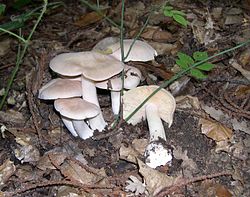| Entolomataceae | |
|---|---|
 | |
| Entoloma sinuatum , Italy | |
| Scientific classification | |
| Kingdom: | Fungi |
| Division: | Basidiomycota |
| Class: | Agaricomycetes |
| Order: | Agaricales |
| Suborder: | Tricholomatineae |
| Family: | Entolomataceae Kotl. & Pouzar (1972) |
| Type genus | |
| Entoloma | |
| Genera | |
Clitocella Contents | |
| Synonyms | |
Clitopilaceae P.D. Orton (1960) nom. inval. | |
The Entolomataceae are a family of fungi in the order Agaricales. The family contains eight genera and 2250 species, the majority of which are in Entoloma . [1] [2] Basidiocarps (fruit bodies) are typically agaricoid (mushrooms with gills), but a minority are cyphelloid. secotioid, or gasteroid. All produce pink basidiospores that are variously angular (polyhedral), ridged, or nodulose. Species are mostly saprotrophic, though a few are parasitic on other fungi. The family occurs worldwide.




